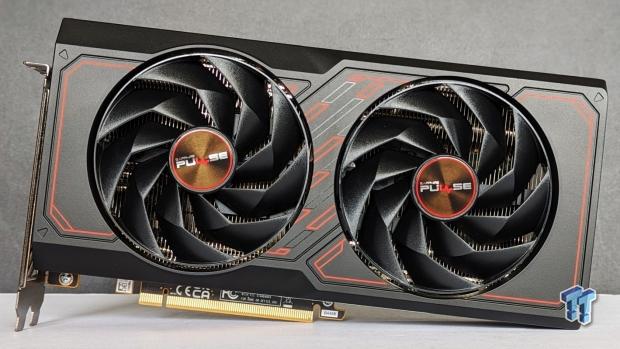The Bottom Line
Pros
- + 16GB of VRAM in a mainstream GPU
- + Solid 1080p performance that competes with the RTX 4060
- + Entry-level 1440p gaming
- + Sturdy build quality from Sapphire
- + FSR 3 and HYPR-RX are promising new technologies
Cons
- - Specs and performance are mostly the same as the Radeon RX 7600
- - The price increase to $329 is a bit steep
- - Ray-tracing performance is a step behind NVIDIA and Intel
- - Not-so-great FSR 3 image quality at 1080p
Should you buy it?
AvoidConsiderShortlistBuyIntroduction
Announced at CES 2024 and launching in the same month as three new GeForce RTX 40 SUPER Series refresh GPUs, it's not surprising that we're getting a new mainstream GPU with the arrival of the Radeon RX 7600 XT - but the form in which it is arriving is. Regarding the chipset and the underlying hardware regarding components, Stream Processors, and Compute Units, the new Radeon RX 7600 XT is - on par - the same GPU as the Radeon RX 7600. Albeit, now with double the VRAM capacity to offer 16GB of GDDR6 memory on a 128-bit bus.
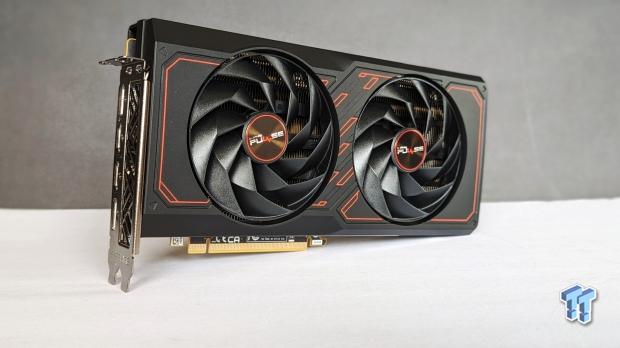
16GB of VRAM on a GPU with a price point of $329 is the headline, no doubt, and outside of Intel's competitively priced Arc A770, we haven't seen a mainstream GPU from AMD or NVIDIA with 16GB of VRAM priced this low before. Memory is costly, and even though outside of a boost to power and clock speeds, you're looking at the same hardware as the Radeon RX 7600 - the price increase from $269 USD to $329 USD looks to be all about whacking another 8GB of GDDR6 memory on the board. It's reminiscent of the GeForce RTX 4060 Ti 16GB launch, which saw a price increase of $100 USD for double the memory.
Granted, market corrections have brought that down to a more reasonable $50-$60 increase, as we see here, but like with the new Radeon RX 7600 XT, it raises the question of... why? Looking at pure 1080p gaming, the Radeon RX 7600's interactive bread and butter, does that extra 8GB of memory (in 2024) mean notably better performance? The answer, for the most part, is no.
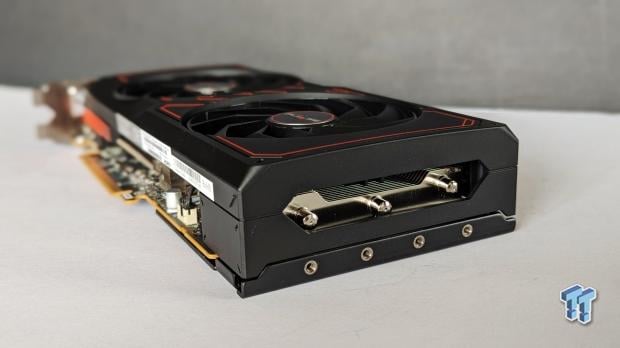
The Radeon RX 7600 XT still delivers the same GeForce RTX 4060 performance levels on average, but the extra memory makes a difference in some memory-intensive games. Also, it helps future-proof the GPU while even going as far as adding 'entry-level 1440p gaming' as a notable feature. Plus, for content creators and AI PCs, having an affordable GPU with 16 GB of memory is a definite plus.
There's much more to the Radeon RX 7600 XT story than memory; the long-awaited launch of HYPR-RX - the driver-based performance-enhancing tool that brings a version of frame generation to hundreds of games - is finally here. Plus, FSR 3 is beginning to show real promise thanks to its appearance in Ubisoft's Avatar Frontiers of Pandora. Let's dig in.

The RDNA 3 Generation
"The world's first chiplet gaming GPU" is how AMD described its new RDNA 3-based GPUs when it lifted the lid on the new Radeon RX 7000 Series. In layperson's terms, the GPU chip isn't just one big square or die anymore, with billions of transistors all arranged in a single layout. Like with its Ryzen CPU range, which embraced chiplet design to great effect (look at how Ryzen has grown in popularity over the years), bringing this design philosophy into the GPU space felt like the natural evolution for AMD's Radeon brand.
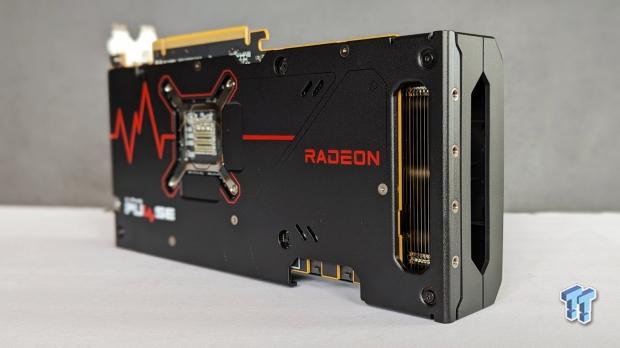
For RDNA 3, what was once a single Graphics Compute Die (GCD) has now split into a GCD plus a Memory Cache Die (MCD). The GCD still makes up most of the hardware grunt and uses the newer 5nm process technology - a step up from RDNA 2's 7nm process. Interestingly, the MCD uses 6nm process technology, which allows AMD to keep costs down as the complexity and cost of manufacturing high-end tech continue to rise.
And to mitigate any performance impact that could arise from going the chiplet route, AMD has also managed to include the "fastest chiplet interconnect in the world," with speeds of 5.3 TB/s. The Radeon RX 7600 and Radeon RX 7600 XT 16GB entry-level models use the 'Navi 33' GPU - a more traditional single-chip setup using 6nm process technology to help keep costs down. But with the same RDNA 3 architecture as the Radeon RX 7700 XT, 7800 XT, and 7900 XT.
AMD's RDNA 3 architecture features second-generation AMD Infinity Cache, another CPU-like feature designed to boost performance in 1440p and 4K gaming - a "bandwidth amplifier" that sits alongside the GDDR6 memory interface. It helps alleviate the need for more expensive and power-hungry memory buses and is one of those forward-thinking designs we love seeing.
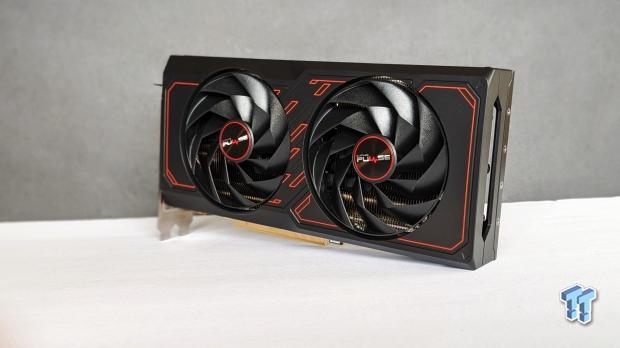
RDNA 3 also represents a significant leap forward for AMD regarding ray-tracing and AI accelerators. RDNA 3 GPUs feature the second generation of dedicated RT hardware and new hardware-based AI acceleration. Real-time ray tracing is hardware intensive; this is one area many were looking for AMD to improve compared to RDNA 2. Which, admittedly, was the company's first attempt at hardware-based ray tracing.
RDNA 3 GPUs are the first graphics cards supporting the new DisplayPort 2.1 spec. The latest DisplayPort interface supports up to 4K 480Hz and even 8K 165Hz, which makes it more of a future-proofing measure than something applicable today. But the real benefit comes with 12-bit HDR support and full Rec2020 coverage for improved color accuracy and detail.
RDNA 3 also introduces hardware-based AV1 encoding to step up its video game for content creators, which means better quality video using the same bitrate. Very cool. For gamers, the introduction of AMD FSR 2 and FSR 3 rendering is fully supported and helps improve performance in intensive games.
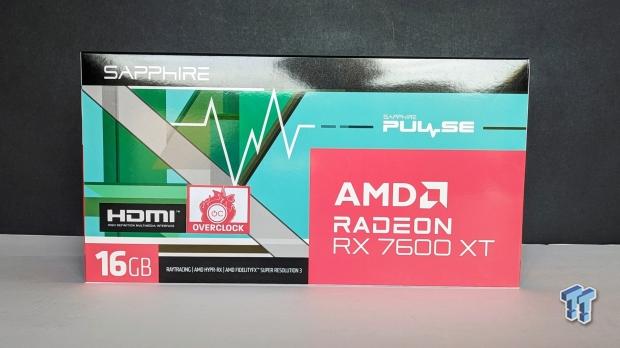
FSR 2 support might not be as widespread as NVIDIA DLSS, but its addition to games like Cyberpunk 2077 and Star Wars Jedi: Survivor is a great sign. Plus, as the tech is supported on Xbox Series X|S and PlayStation 5 (with both consoles using AMD graphics hardware), in-game FSR support should grow as time passes. In late 2023, AMD introduced its DLSS 3-like FSR 3 frame generation technology, which uses generated frames and low-latency tech to boost perceived performance.
With FSR 3's launch limited to a handful of games, AMD's journey into frame generation is leveling up in 2024. With FSR 3 support now being added to several games, AMD has also debuted its full driver-based HYPR-RX suite for Radeon RX 7000 and RX 6000 owners that allows players to enable Radeon Boost upscaling, AMD Fluid Motion Frames frame generation, and AMD Anti-Lag at the global level - instantly boosting performance in countless titles.
RDNA 3 is a leap forward for AMD on several fronts: performance, software, and even AI, bringing massive changes to the underlying hardware while delivering new and exciting features to PC gamers everywhere.
Specs and Test System
Specifications
Here, we can see how the specs and hardware stack up for the AMD Radeon RX 7600 XT compared to the AMD Radeon RX 7600 and AMD Radeon RX 7700 XT.
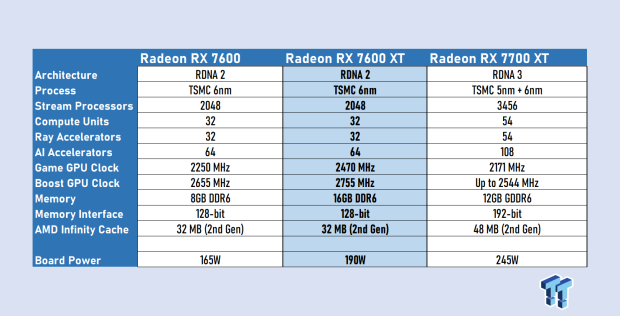
As mentioned in the introduction, the new Radeon RX 7600 XT shares the same GPU or chip as the Radeon RX 7600 - with the same number of Stream Processors, Compute Units, Ray Accelerators, and AI Accelerators. The reason for this is that the Radeon RX 7600 already features a fully unlocked 'Navi 3' chip, so there wasn't any way to add more Compute Units without making drastic changes or going the chiplet route of the Radeon RX 7700 XT. That said, AMD believes boosting clock speeds and doubling the VRAM capacity to 16GB is enough to warrant the 'XT' tag instead of simply calling this the Radeon RX 7600 16GB.
16GB is wonderful to see, but it's worth highlighting that it is still on a slower 128-bit bus, so it's not the same memory speed you'd get from the 12GB on the Radeon RX 7700 XT. This is improved with AMD's 32MB of second-generation Infinity Cache, which improves 1% low FPS performance thanks to decreasing memory traffic.
The downside to boosting clock speeds and doubling VRAM is that the Radeon RX 7600 XT's power rating has increased by 15% compared to the Radeon RX 7600 to 190W. The result is a card like the SAPPHIRE PULSE AMD Radeon RX 7600 XT 16GB reviewed here, requiring two 8-pin power connectors instead of just one. AMD's RDNA 3 generation isn't exactly kicking goals regarding power efficiency, especially when a far more powerful GPU like the GeForce RTX 4070 only requires a single 8-pin power connector.
Ultimately, the Radeon RX 7600 XT doesn't do a lot to close the hardware (and performance gap) between mainstream RDNA 3 and the mid-range Radeon RX 7700 XT, which features a massive 68.8% higher Stream Processor, Compute Unit, and Ray Accelerator count than what you find here and in the baseline Radeon RX 7600.
- GPU: AMD Radeon RX 7600 XT
- Model: SAPPHIRE PULSE AMD Radeon RX 7600 XT 16GB
- Interface: PCI Express 4.0
- Stream Processors: 2048
- Clock Speeds: Up to 2755 MHz (Boost Clock)/Up to 2470 MHz (Game Clock)
- Memory: 16GB GDDR6
- Memory Speed: 18 Gbps
- Memory Interface: 128-bit
- Display Connections: 2 x HDMI, 2 x DisplayPort
- Power Connectors: 2 x 8-pin
- Total Board Power: 190W
- What's in the Box: SAPPHIRE PULSE AMD Radeon RX 7600 XT 16GB
Kosta's Test System
- Motherboard: MSI MPG X670E Carbon Wi-Fi
- CPU: AMD Ryzen 9 7900X
- Cooler: Corsair iCUE H100i RGB PRO XT Liquid CPU Cooler
- RAM: 64GB (2x32GB) Corsair DOMINATOR PLATINUM RGB DDR5 DRAM 5200MHz
- SSD: Sabrent Rocket 4 Plus-G M.2 PCIe Gen 4 SSD 4TB, Sabrent Rocket 4 Plus M.2 PCIe Gen 4 SSD 8TB
- Power Supply: Thermaltake Toughpower GF1 850W
- Case: Thermaltake Core P3 Tempered Glass Snow
- OS: Microsoft Windows 11 Pro 64-bit
Physical Design and Cooling
The SAPPHIRE PULSE AMD Radeon RX 7600 XT is slightly larger than the Radeon RX 7600 version we reviewed back when the 7600 first launched with dimensions of 250 x 129.25 x 44.56 mm and an overall 2.2-slot thickness. It's still compact and relatively lightweight, which is always a plus for mainstream GPUs - in that it won't have any real problem fitting into most cases and builds. The SAPPHIRE PULSE AMD Radeon RX 7600 XT is a definite upgrade choice for those rocking a GPU two or three generations old, and installation is a breeze.
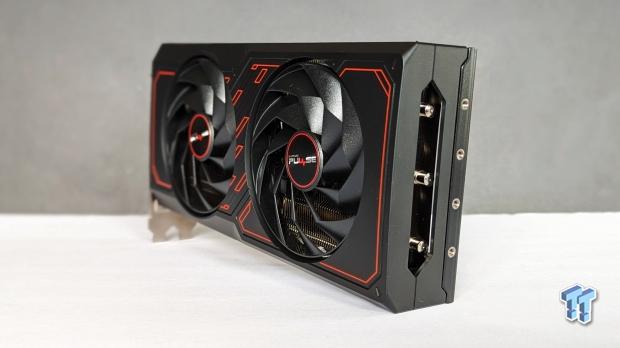
The build quality here is sturdy, too, something we've come to expect from Sapphire - a company that consistently creates quality Radeon cards from the metal backplate to the sizeable and reliable dual-ball bearing fans to the composite heat pipes and fuse protection on the PCB. The good news is that even though it does run a little warmer than the Radeon RX 7600 version of the Sapphire PULSE (and this difference could be chalked up to the Australian summer), the cooling and thermal performance is still on par with what we've seen before.
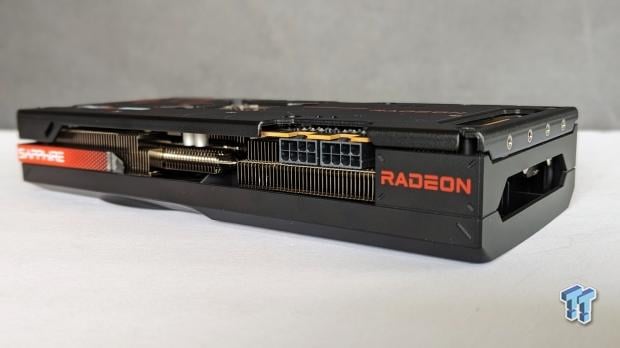
The physical design and look maintain the Sapphire PULSE mix of black with bold red accents in a nod to Radeon and Team Red. Even though the back side is vented like the Radeon RX 7600 version, it's not as prominent due to what looks like an overall larger PCB design for the Radeon RX 7600 XT - an interesting, if not all, useful tidbit.
Benchmarks - 15 Game Averages
The Games and Tests
PC gaming is a complicated and varied space, from indie games to major blockbuster releases and titles that push hardware and technology to their limit with the adoption of effects like real-time ray-tracing.

This is all a way of saying that the 15 in-game benchmarks we've chosen (and run at 1080p and 1440p) represent a wide range of styles, not only in terms of genres, like first-person shooters and racing games but also in the API technology (DirectX 11, 12) and cutting-edge features like ray tracing and upscaling technology.
Results include DLSS and FSR 2, where possible, as both technologies are the sorts of things, especially in 1440p and 4K, which you'd turn on. Six of the 15 game benchmarks also feature ray tracing. Also, each title is set to ultra-equivalent quality settings to push GPU hardware and minimize CPU bottlenecks at higher resolutions.
Also, it's just fun to max out a game's visual settings and see the results. Here's the breakdown of games, graphics settings, and what's being tested.
- Assassin's Creed Valhalla: Ultra High-quality settings, with the in-game benchmark tool used.
- Borderlands 3: Ultra quality settings, with the in-game benchmark tool used.
- Call of Duty: Modern Warfare II: Ultra quality setting, in-game multiplayer benchmark tool used.
- Cyberpunk 2077: Ultra quality setting, in-game benchmark tool used. AMD FSR and NVIDIA DLSS results are included.
- Cyberpunk 2077 (RT): Ray tracing Ultra quality setting, in-game benchmark tool used. AMD FSR and NVIDIA DLSS results are included.
- DOOM Eternal (RT): Ultra Nightmare quality setting with ray-tracing enabled, the opening of Mars Core campaign level used to benchmark.
- F1 22 (RT): Ultra High-quality setting with ray tracing, one lap of the Bahrain track benchmarked. AMD FSR and NVIDIA DLSS results are included.
- Forza Horizon 5 (RT): Extreme quality setting with ray tracing enabled, in-game benchmark tool used. AMD FSR and NVIDIA DLSS results are included.
- Hitman (RT): Ultra-quality settings with ray-tracing, Dubai scene benchmarked. AMD FSR and NVIDIA DLSS results are included.
- Horizon Zero Dawn: Ultimate quality setting, in-game benchmark used.
- Marvel's Guardians of the Galaxy (RT): Ultra quality setting with ray tracing enabled, the in-game benchmark tool used.
- Rainbow Six Extraction: Ultra quality settings and in-game benchmark tool used.
- Red Dead Redemption 2: Maximum quality settings, with in-game benchmark tool used. AMD FSR and NVIDIA DLSS results are included.
- The Division 2: Ultra quality settings with in-game benchmark tool used.
- Total War: Warhammer III: Ultra-quality settings with the in-game Battle Benchmark tool used.
15 Game Average FPS - 1080p Results
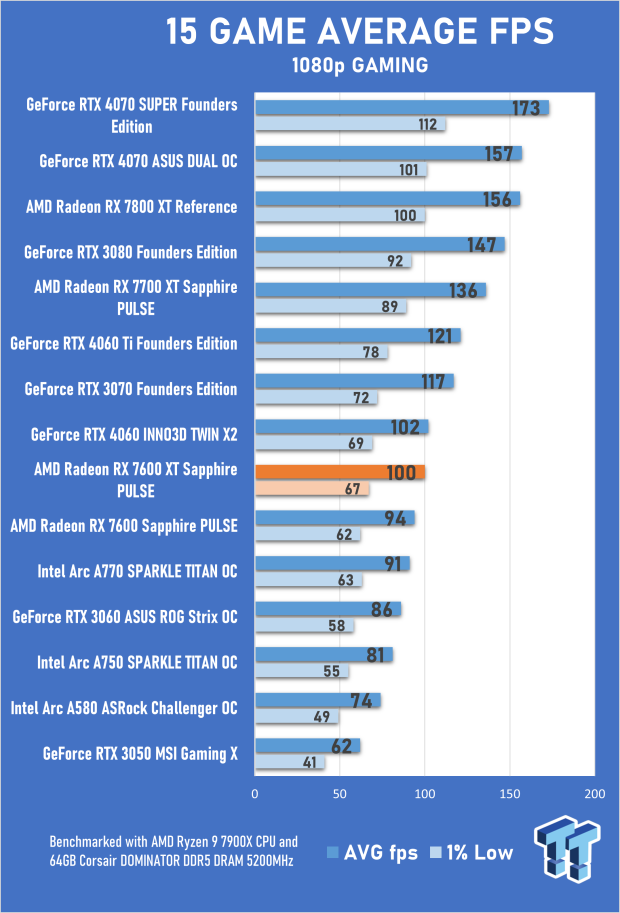
If you were expecting a notable leap forward in 1080p gaming performance with the Radeon RX 7600 XT, prepare to be somewhat disappointed. Not that you should have been, with the 7600 and 7600 XT being mostly the same outside of the increase in VRAM capacity. The interesting thing to note here is that even though we're comparing the SAPPHIRE PULSE AMD Radeon RX 7600 XT 16GB to the SAPPHIRE PULSE AMD Radeon RX 7600 8GB, the latter is an OC model that pushes clock speeds to 7600 XT levels out-of-the-box - which is something seen in many Radeon RX 7600 cards.
Okay, so for 1080p gaming across our 15-game benchmark suite that includes several games with ray-tracing enabled, the SAPPHIRE PULSE AMD Radeon RX 7600 XT is roughly 6.4% faster than the Radeon RX 7600, 16.3% faster than the GeForce RTX 3060 12GB, and 9.9% faster than the Intel Arc A770 which also features 16GB of VRAM. Hitting an average of 100 FPS with a respectable 1% low figure above 60 FPS puts the Radeon RX 7600 XT's 1080p gaming performance in line with the GeForce RTX 4060.
There is more to the story here as there are many non-ray-tracing titles where the Radeon RX 7600 XT holds a commanding performance lead over the GeForce RTX 4060 at this resolution. Borderlands 3, Call of Duty: Modern Warfare II, Cyberpunk 2077, and Forza Horizon 5, with Call of Duty performance even beating the GeForce RTX 4060 Ti. Ray-tracing is a weak spot here, with the Radeon RX 7600 XT falling behind the Intel Arc A770 and GeForce RTX 3060 in some games.
14 Game Average FPS - 1440p Results
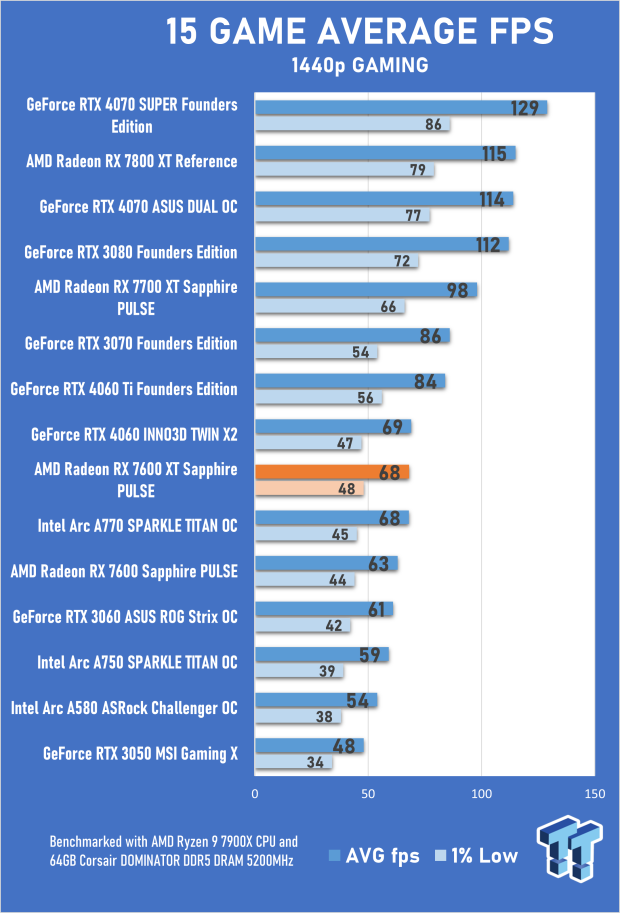
Making the jump to 1440p and the performance drop-off for the SAPPHIRE PULSE AMD Radeon RX 7600 XT is 32%, a similar number to what we found when it came to 8GB models for the Radeon RX 7600. However, the performance lead over the baseline Radeon RX 7600 increases at 1440p to 7.9%, while its lead over the GeForce RTX 3060 12GB decreases to 11.5%. Interestingly, even though performance varies from game to game, the Radeon RX 7600 XT, GeForce RTX 4060, and Intel Arc A700 are all on par regarding 1440p gaming.
At this point, you might be wondering what the 16GB of VRAM is bringing to the table if anything. A single-digit percentage increase in overall performance isn't exactly the stuff of legend. However, there are games where the difference is felt, and Call of Duty at 1440p is one. Here, performance increases by 13.5% compared to the Radeon RX 7600. Forza Horizon 5's 1440p performance increases by 17.8% to deliver a smoother experience, while DOOM Eternal sees performance increase by 32.4% over the Radeon RX 7600.
So, yes, 16GB of VRAM can make a big difference - but for the most part, the Radeon RX 7600 XT performs like a Radeon RX 7600. The good news is that the 1440p performance bump and the future-proofing that comes from having 16GB of VRAM do bode well for the long-term value of the new mainstream RDNA 3 offering.
Benchmarks - 3DMark FireStrike
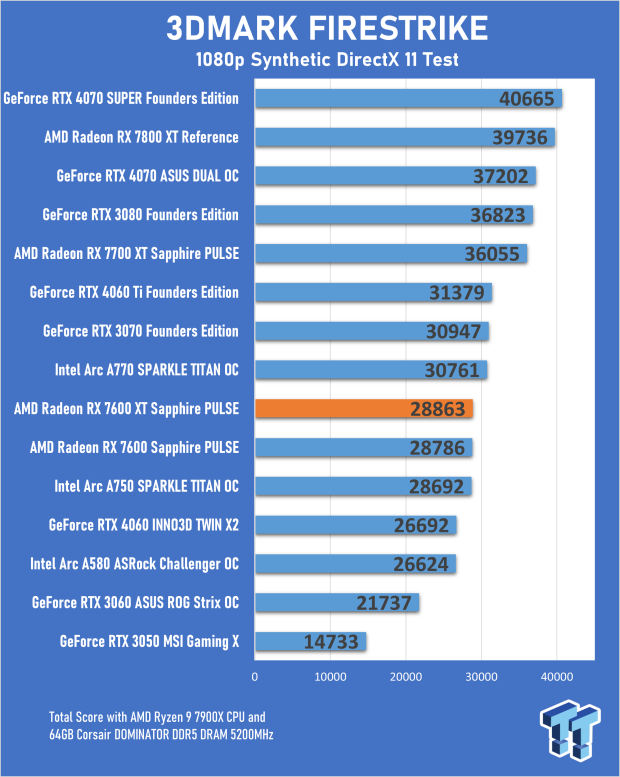
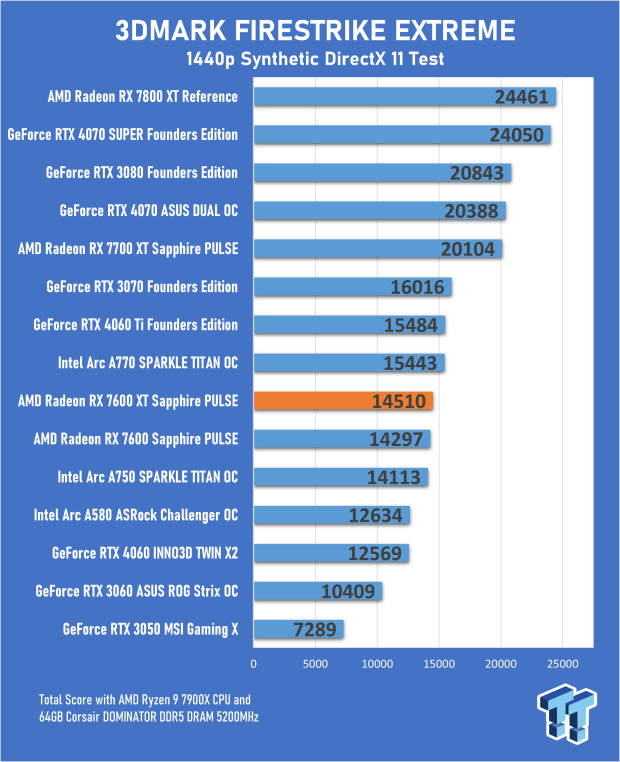
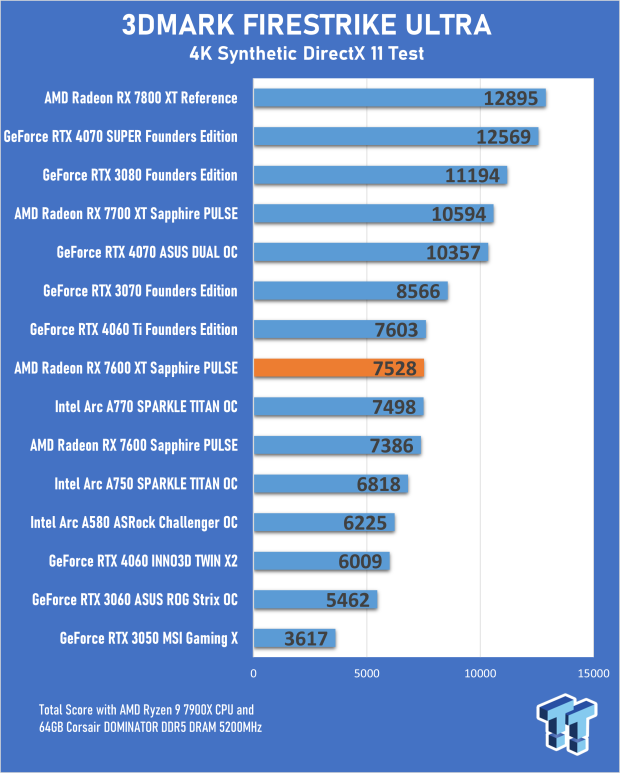
3DMark FireStrike is a synthetic DirectX 11 benchmark that has been around for years and covers quite a large portion of games released over the past decade. The three tests cover the resolutions - 1080p, 1440p, and 4K. The 1080p and 1440p tests show that the SAPPHIRE PULSE Radeon RX 7600 XT performs the same as the Radeon RX 7600 - pointing to these 3DMark tests not requiring more than 8GB of VRAM.
Even as a synthetic benchmark, the Radeon RX 7600 XT doesn't necessarily translate to real-world in-game numbers, as the scores here paint the picture of a GPU that is notably more powerful than the GeForce RTX 4060.
Benchmarks - 3DMark TimeSpy and Port Royal
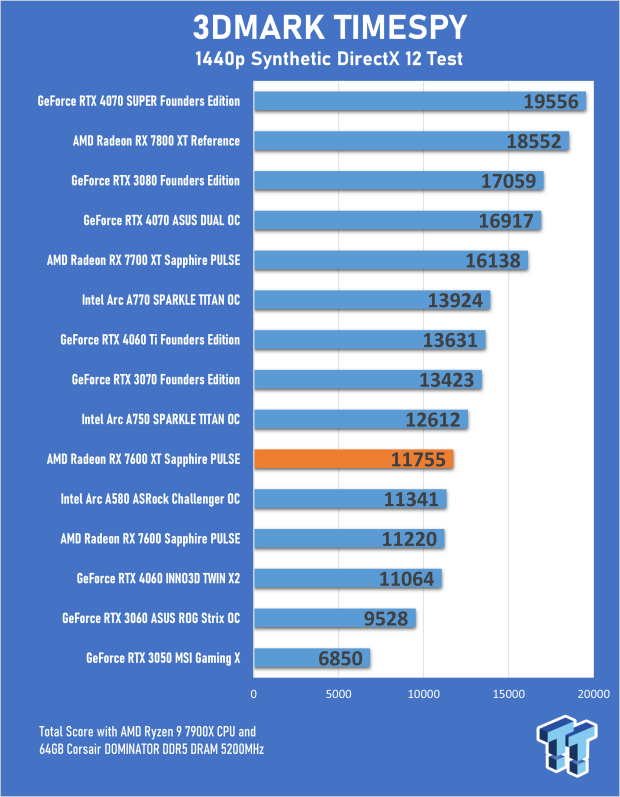
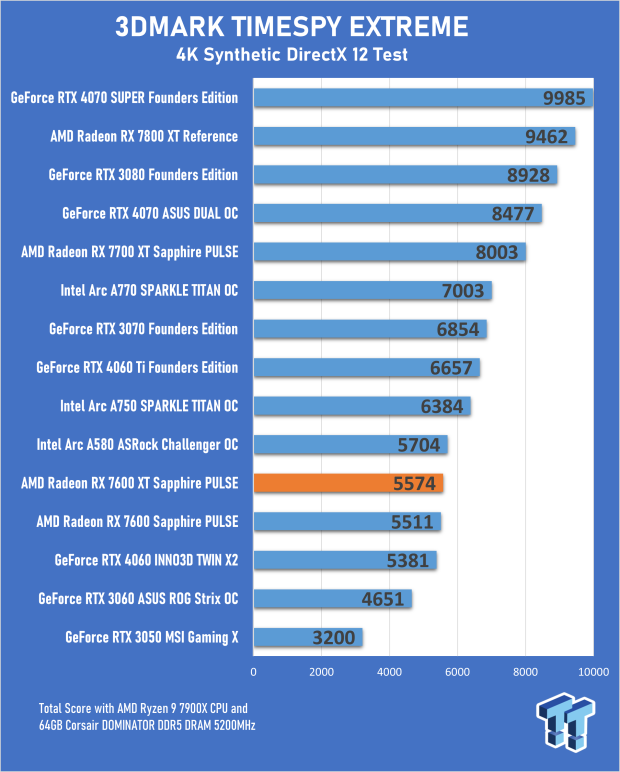
3DMark TimeSpy is DirectX 12-based, so it's a more relevant synthetic benchmark for modern games, and once again, the Radeon RX 7600 XT result is right there, close to the Radeon RX 7600 score. It's also close to the GeForce RTX 4060 score, which aligns with the 1440p average we saw in our 15-game benchmark suite. The 3DMark TimeSpy results also further highlight the performance gap between the Radeon RX 7600 XT and the beefier Radeon RX 7700 XT - to 27%. This makes it feel like AMD could slot in another GPU somewhere.
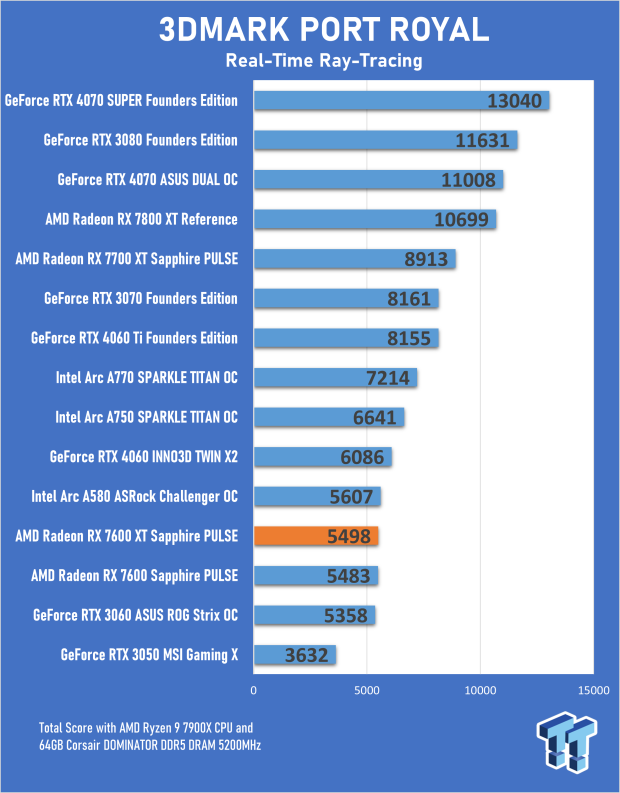
3DMark Port Royal is a synthetic ray-tracing benchmark - an area in which the Radeon RX 7600 XT, with its forward-thinking 16GB of VRAM, is still a step behind the competition. With a score of 5498, the SAPPHIRE PULSE AMD Radeon RX 7600 XT sits in between the GeForce RTX 3060 and GeForce RTX 4060. As far as RDNA 3 cards go, the entry-level Radeon RX 7600 XT isn't something you'd consider for intensive real-time ray tracing.
Benchmarks - 1080p Gaming
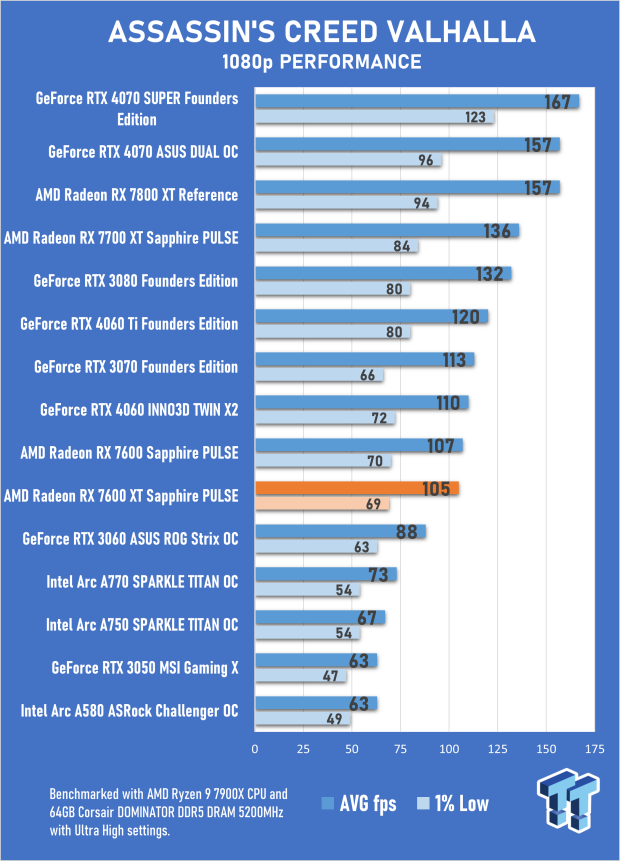
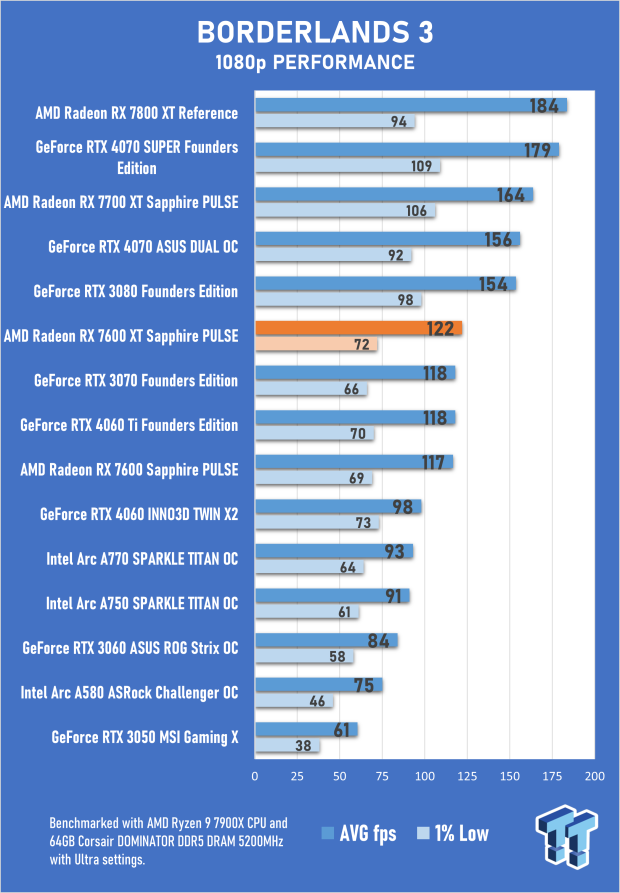
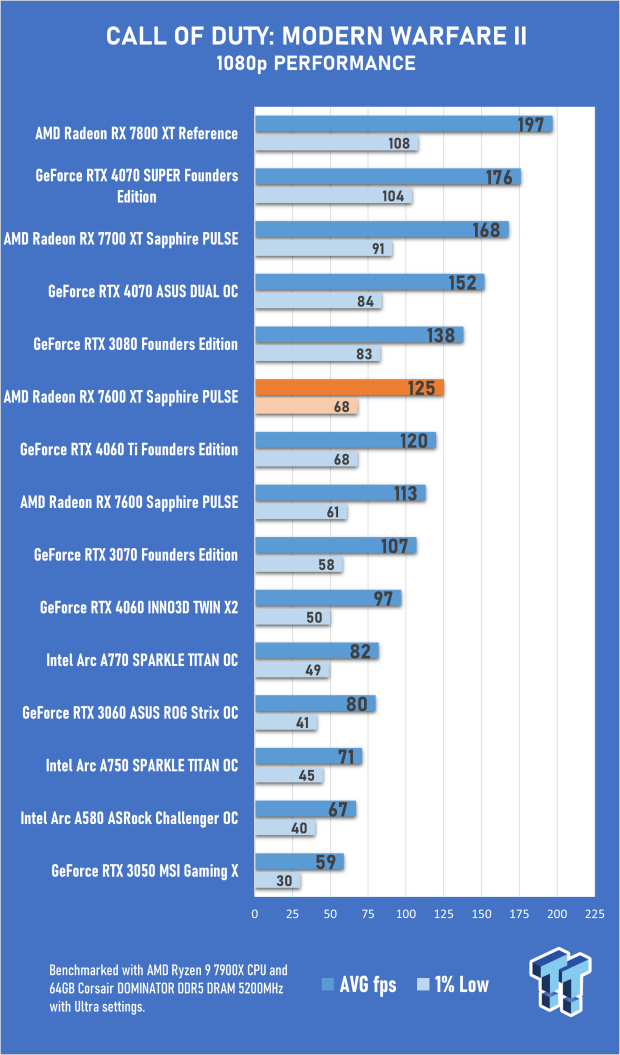
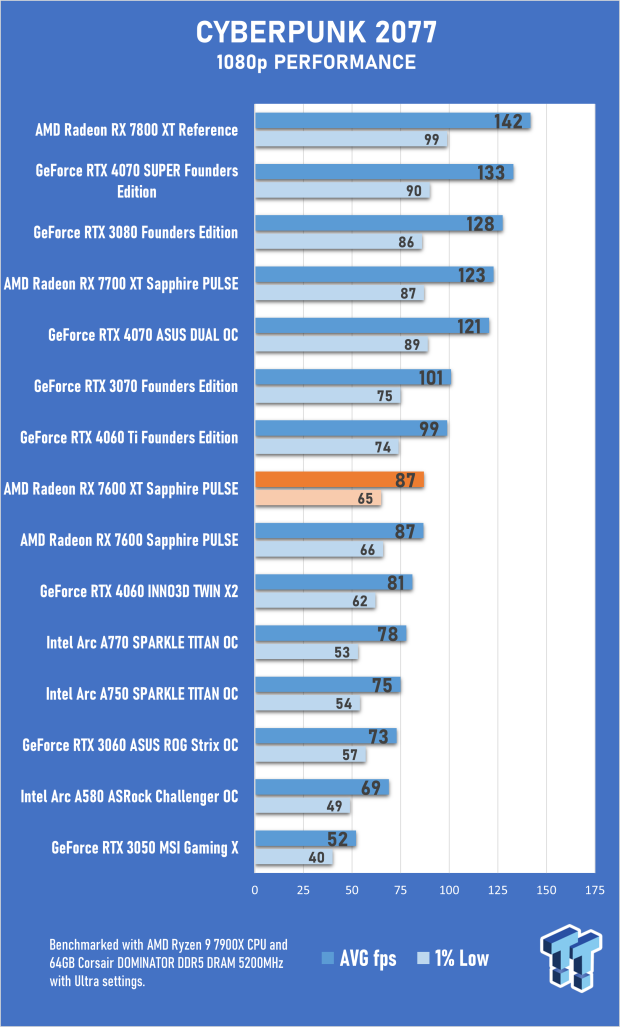
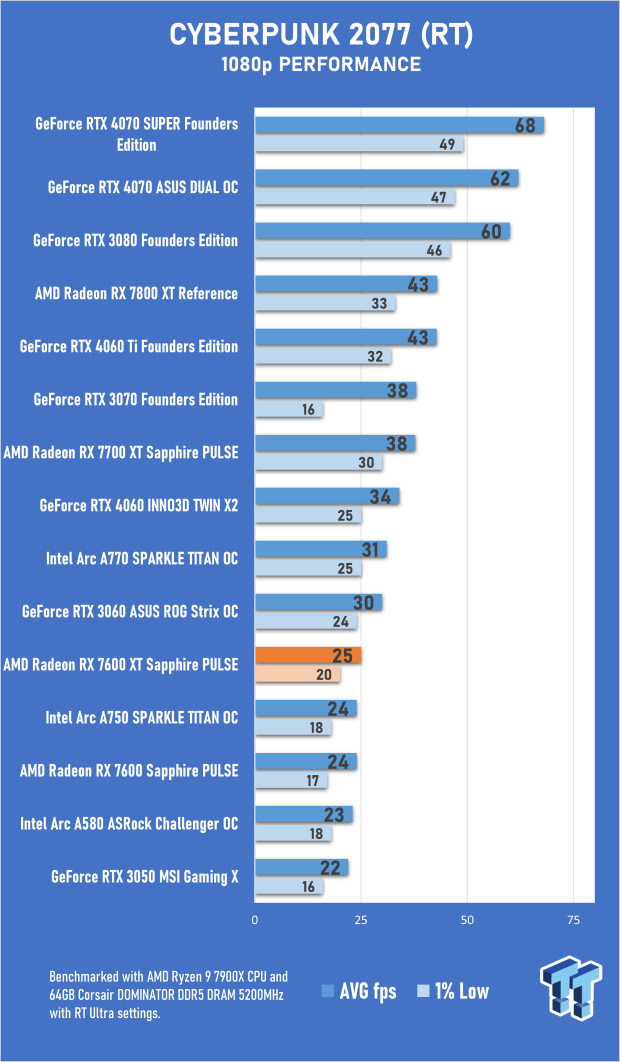
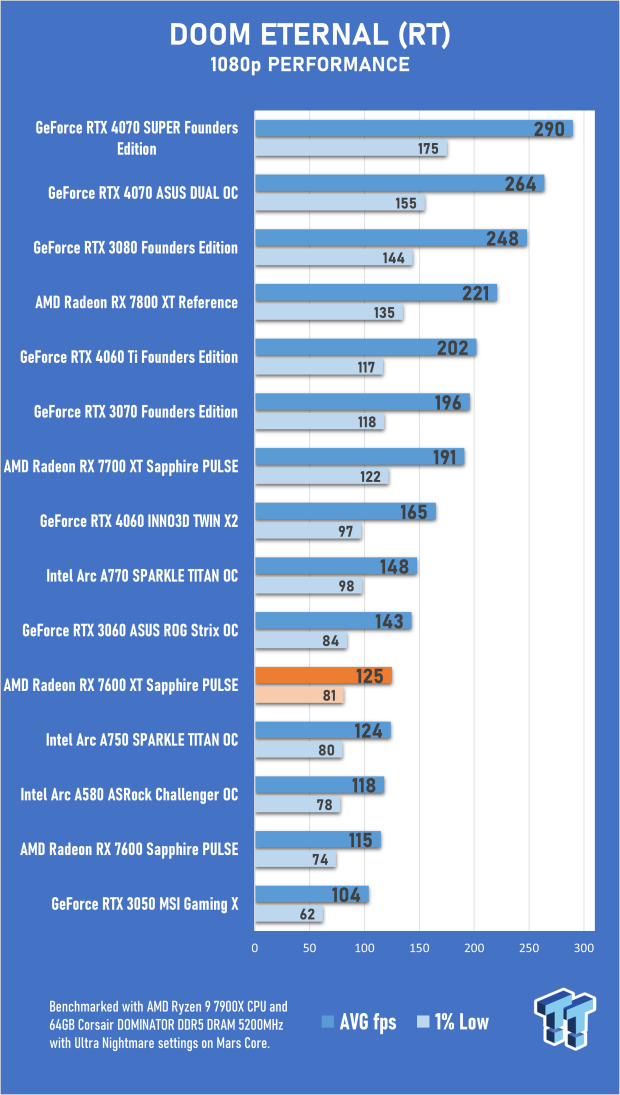
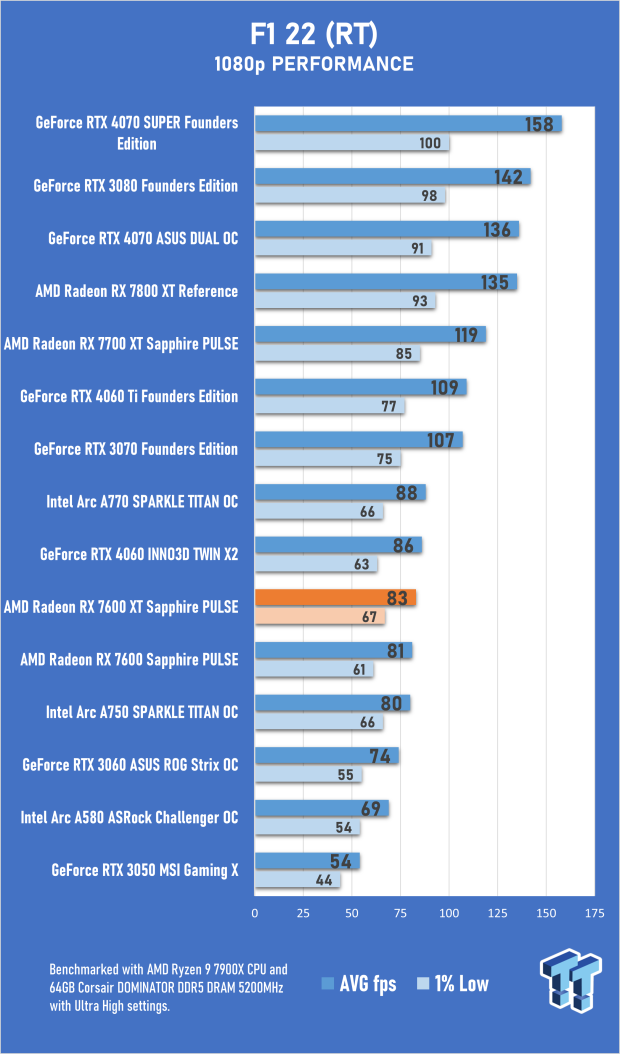
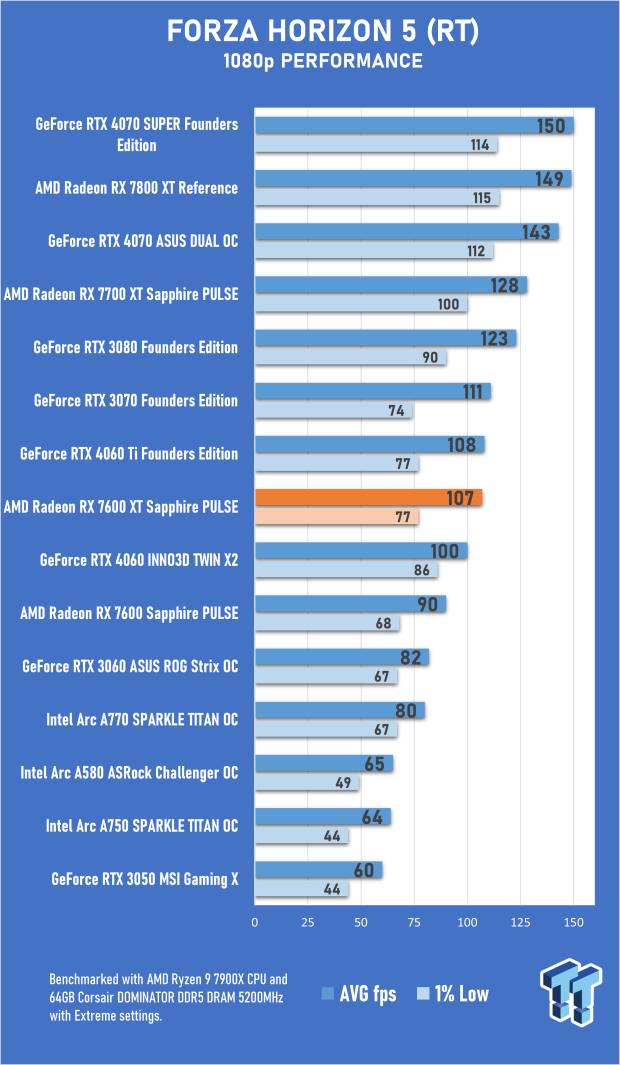
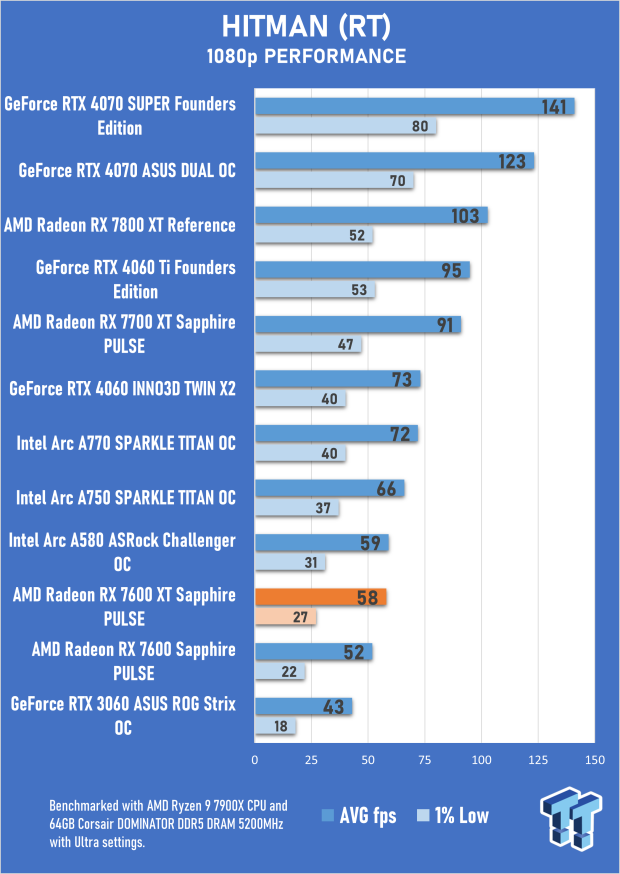
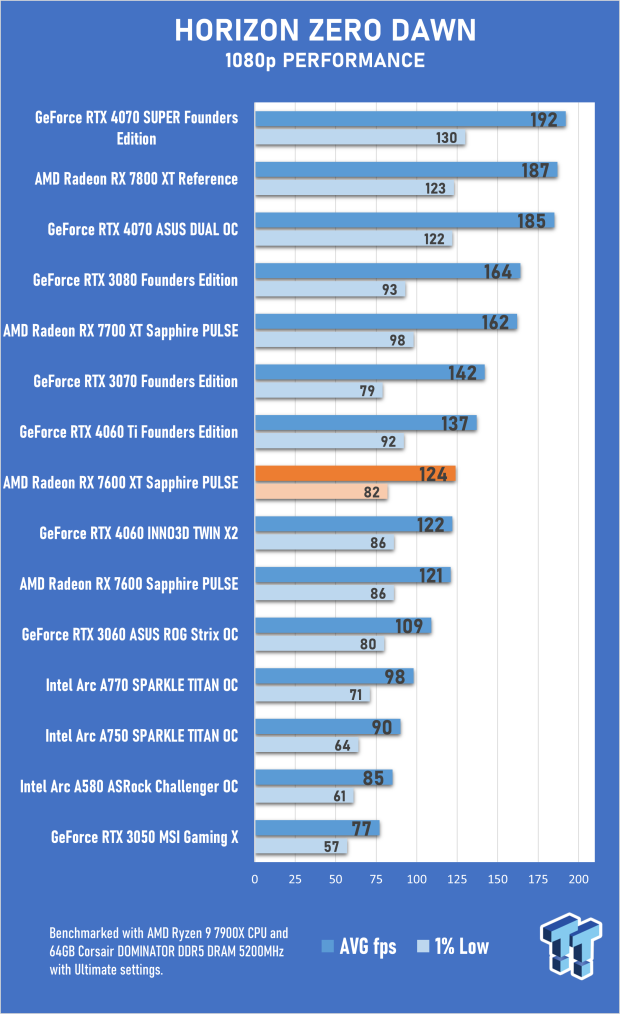
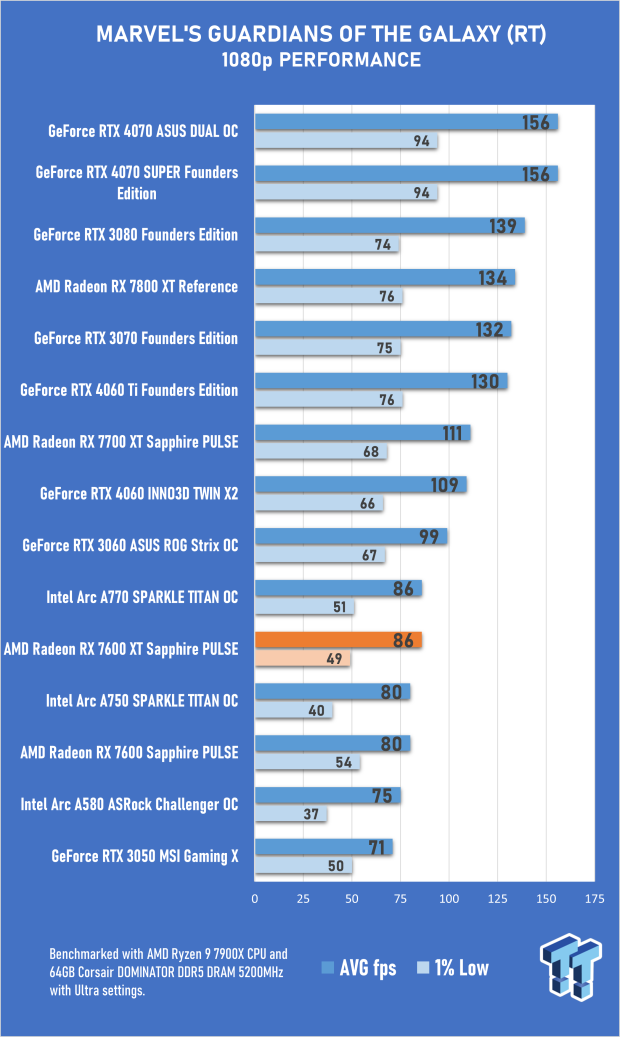
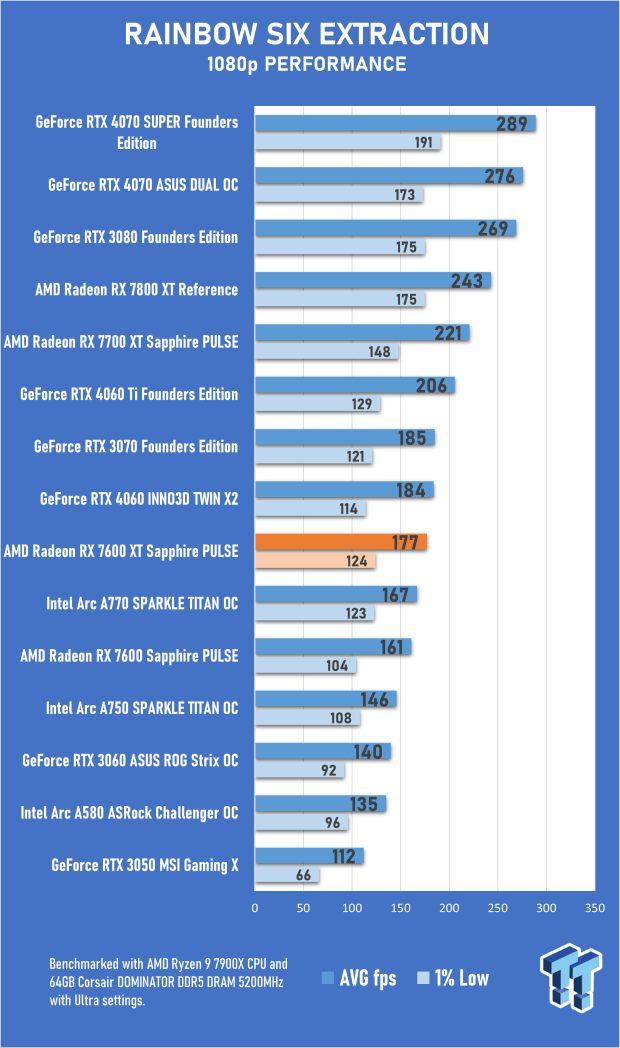
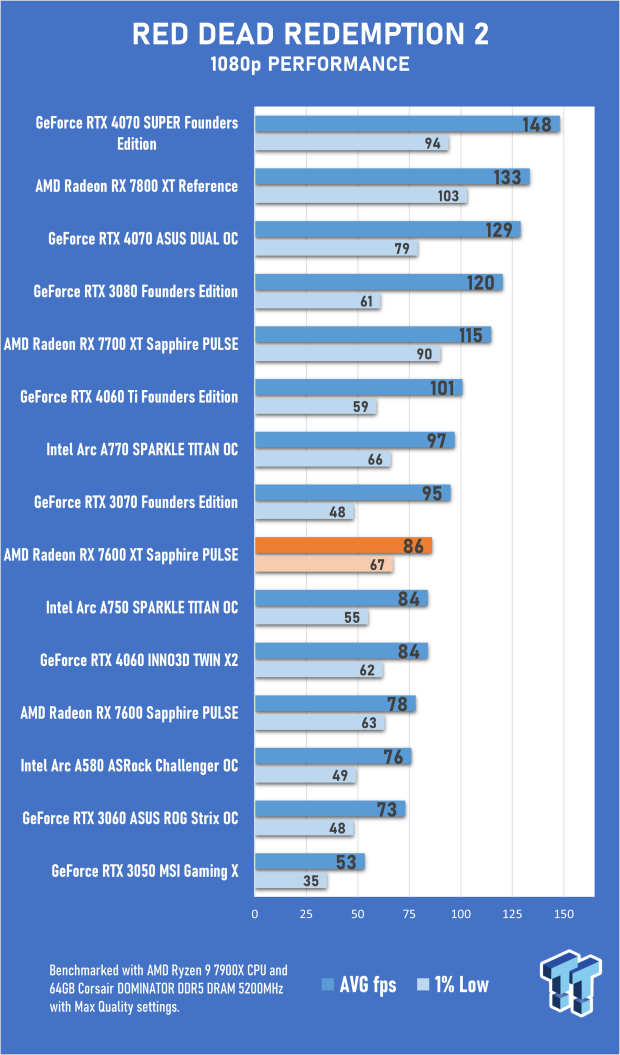
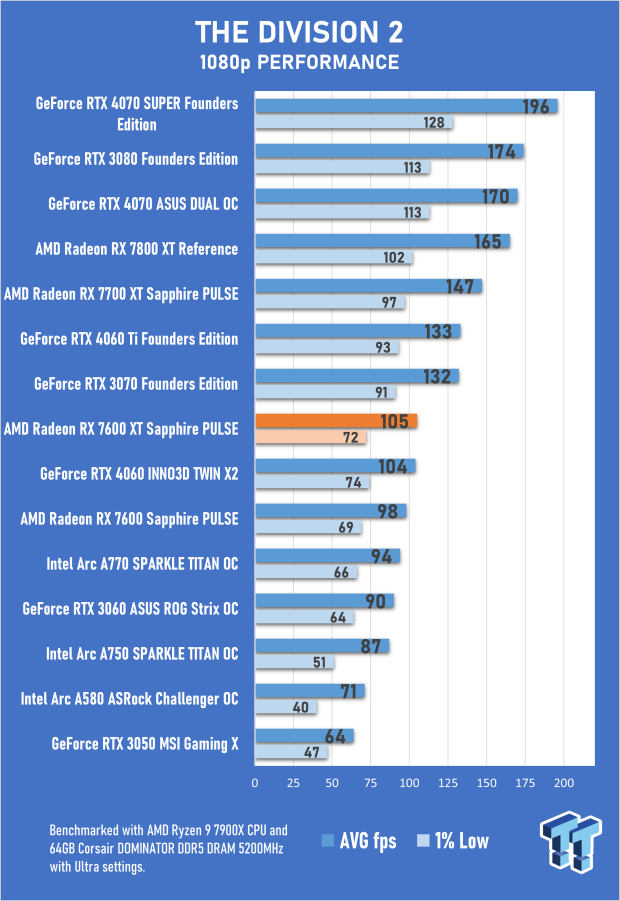
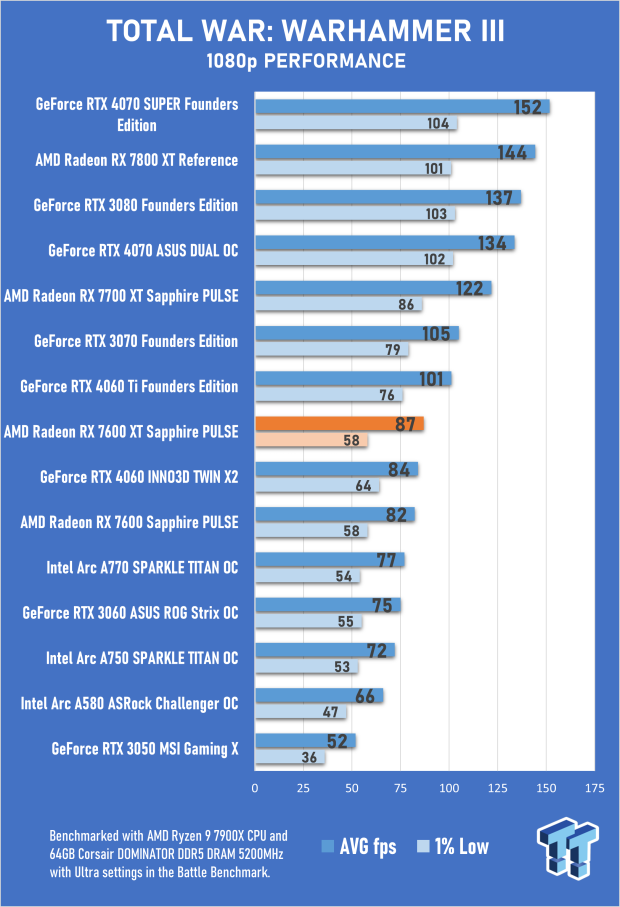
Benchmarks - 1440p Gaming
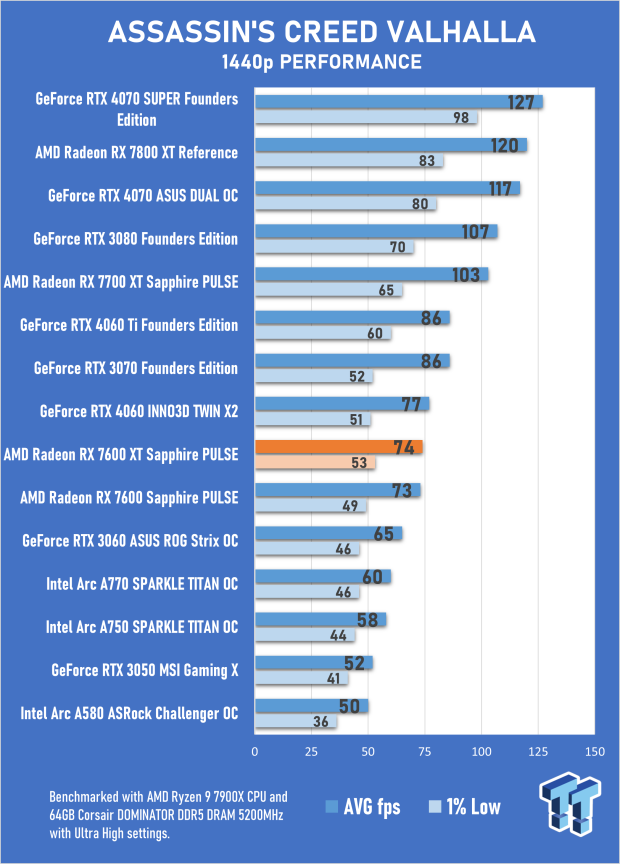
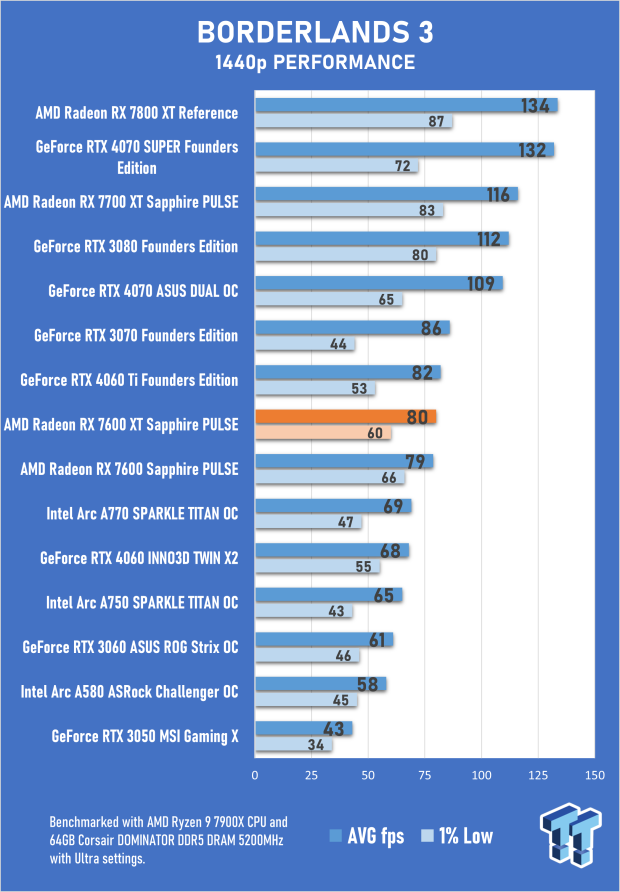
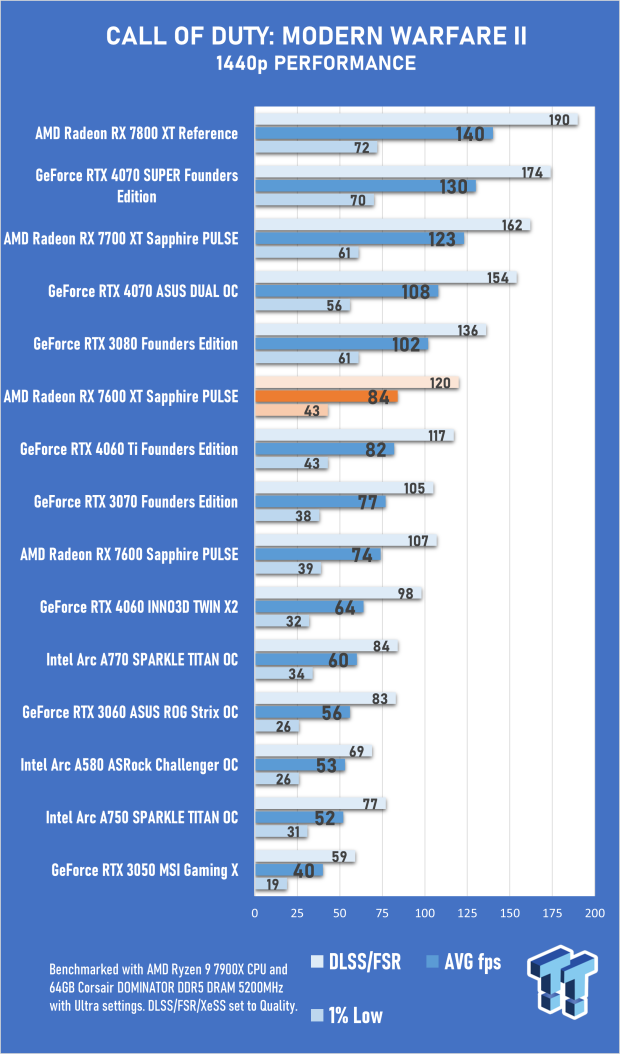
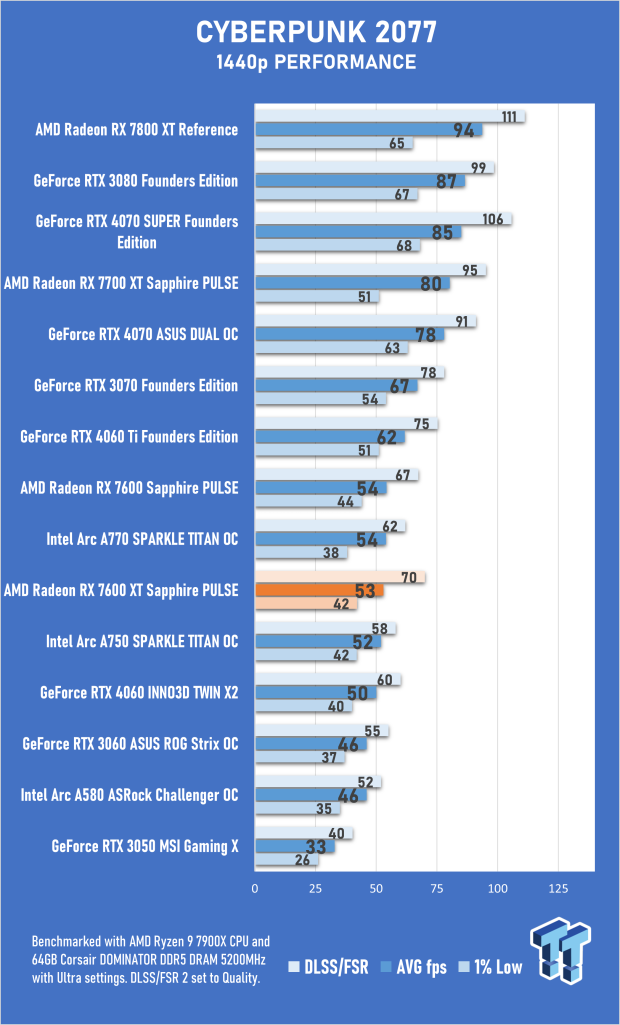
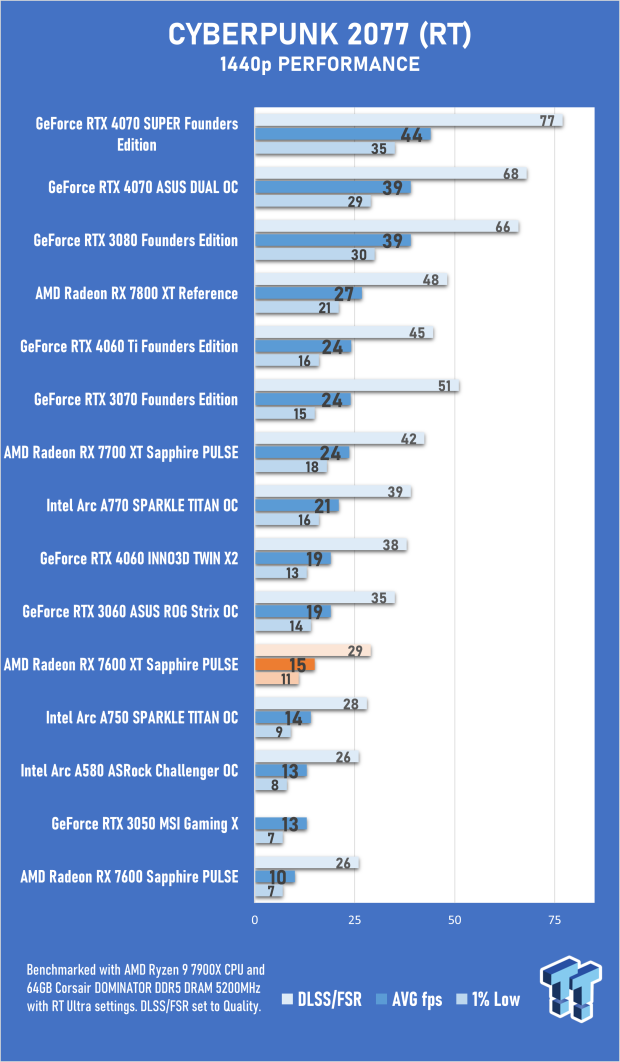
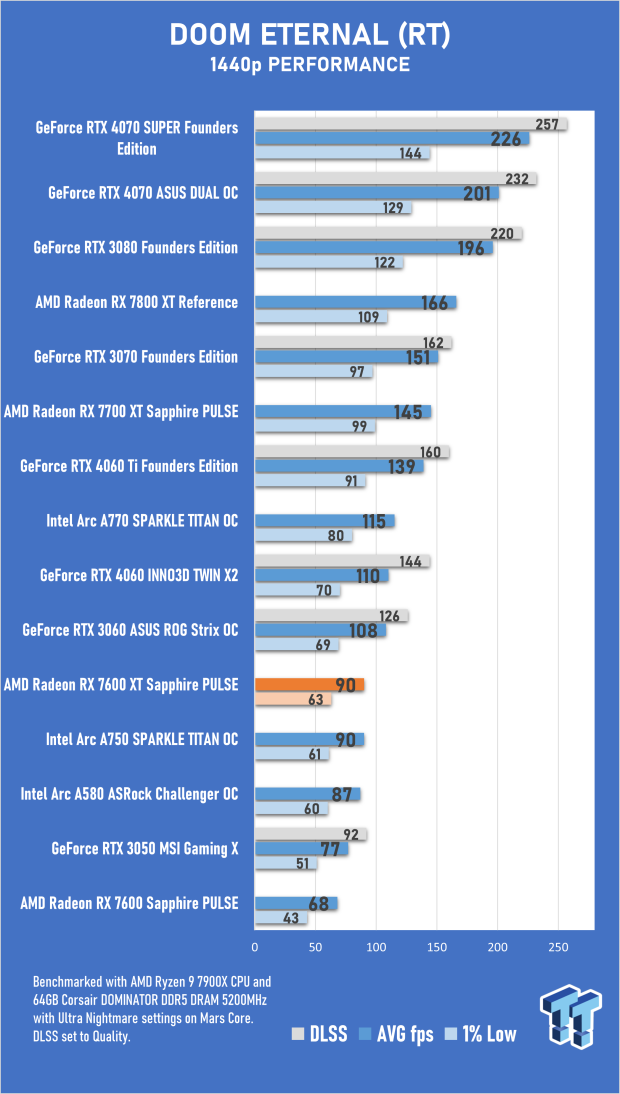
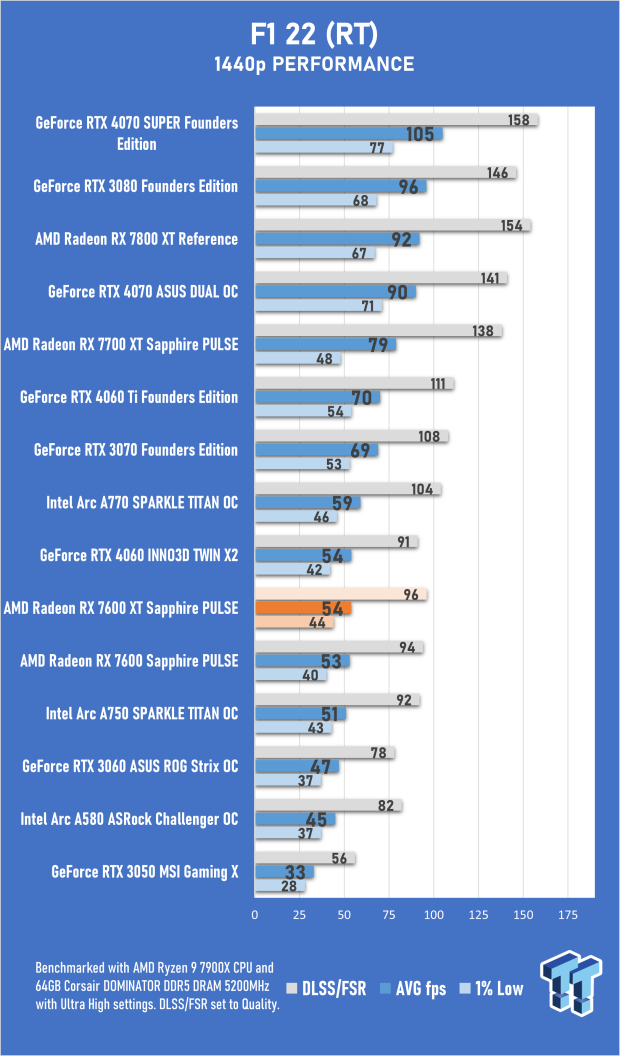
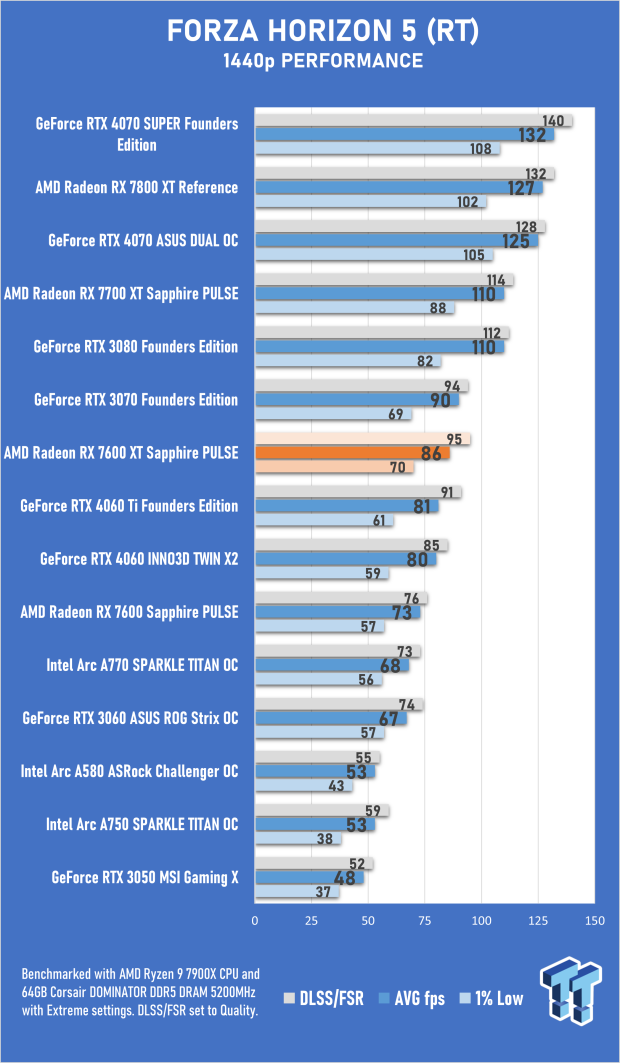
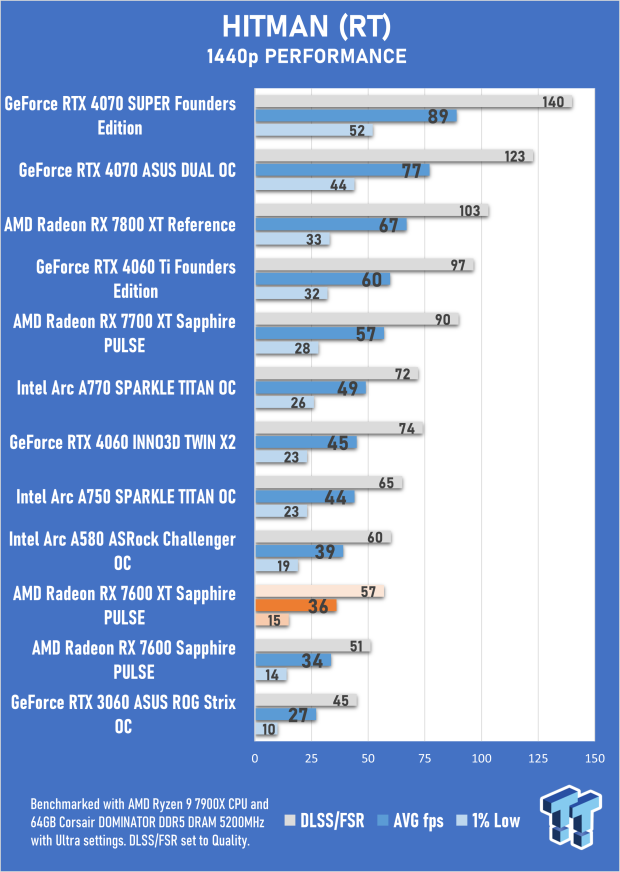
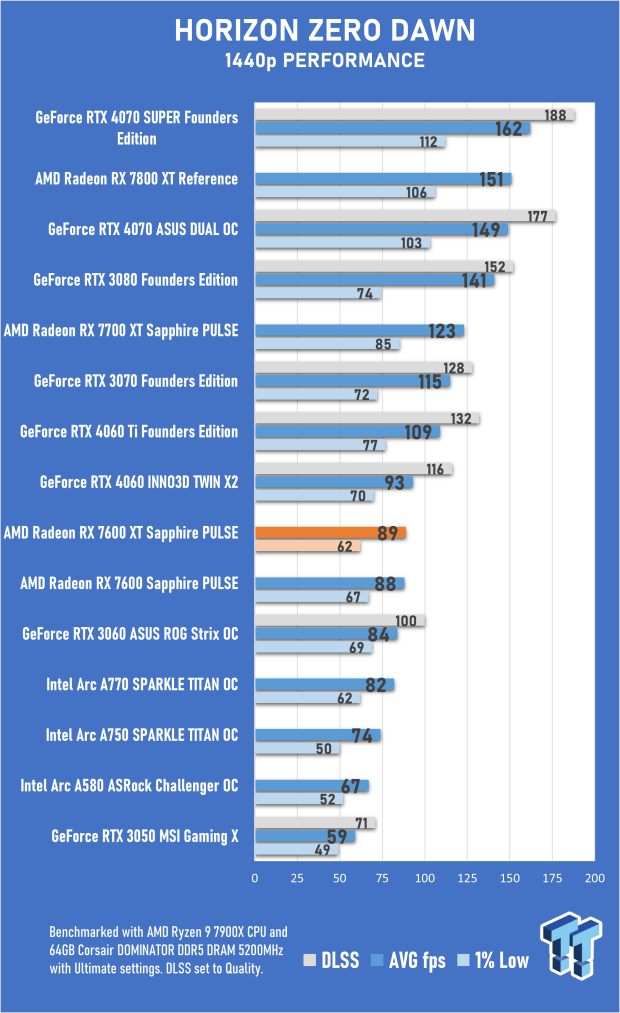
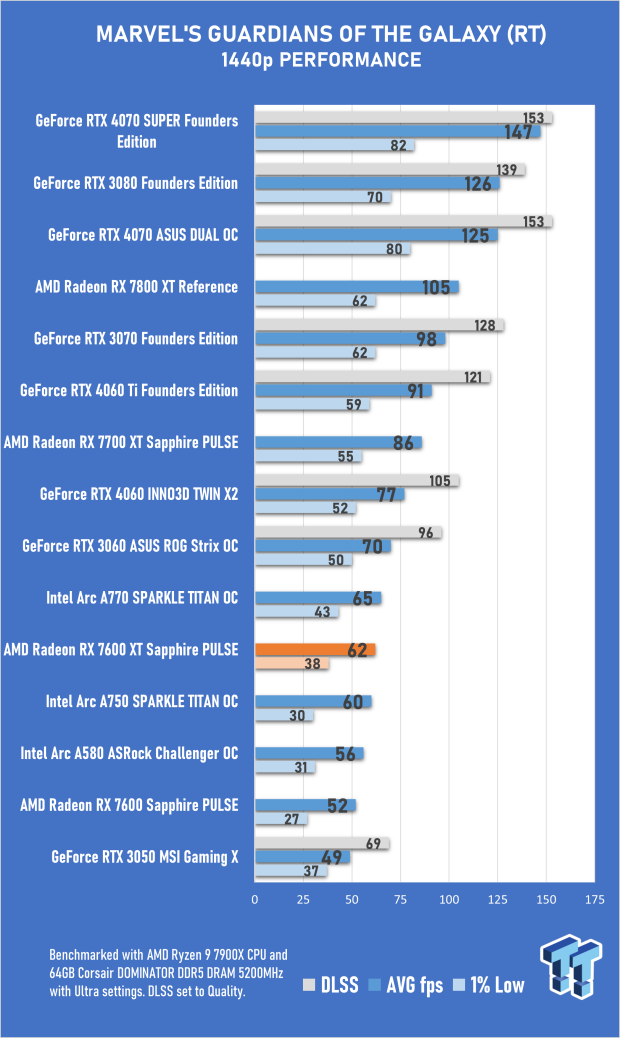
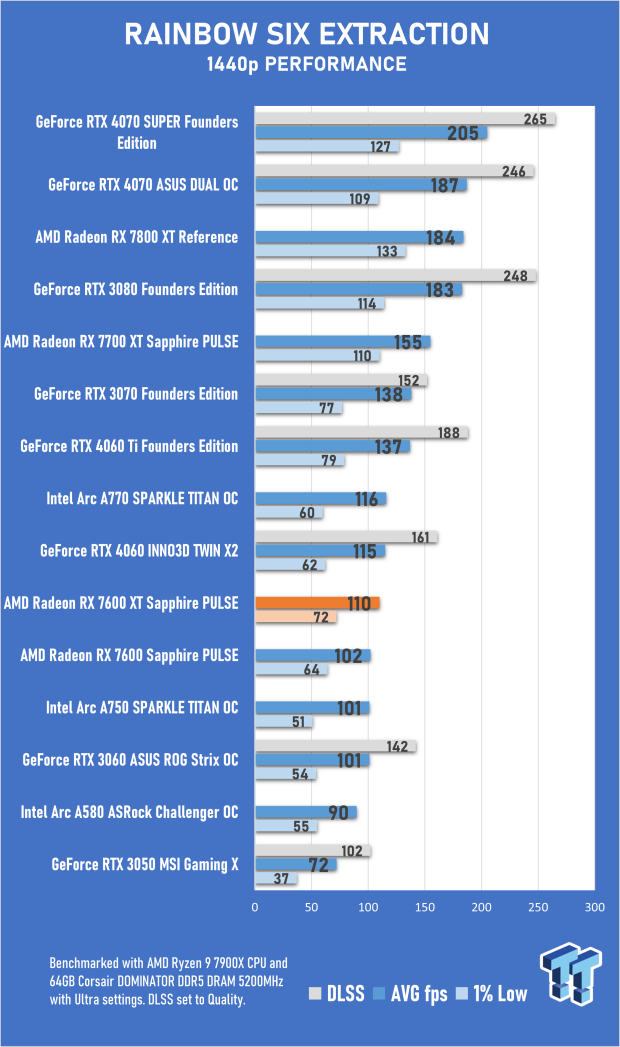
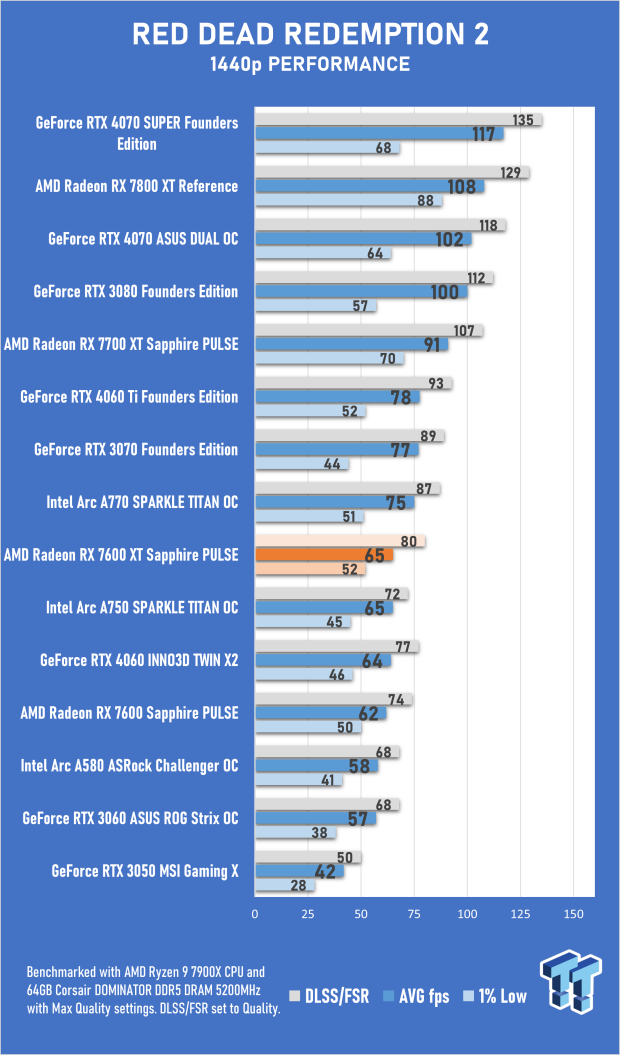
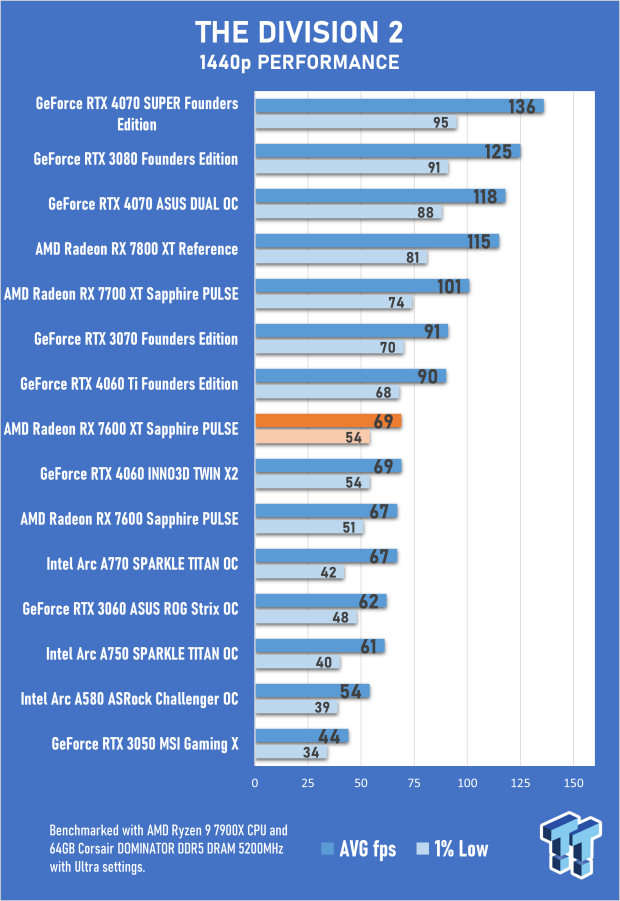
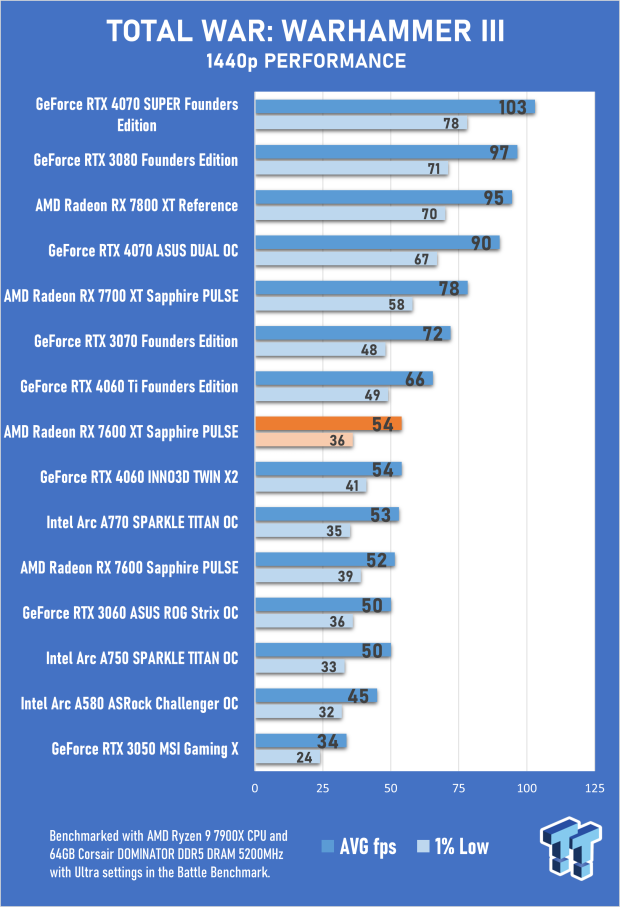
Benchmarks Summary, FSR 3, and HYPR-RX Fluid Motion Frames
As a mainstream gaming GPU with 16GB of VRAM, there's much to like about the new Radeon RX 7600 XT - especially when the additional VRAM makes a big difference in games where having 8GB is seemingly the bottleneck. Games like DOOM Eternal see performance improve to the tune of 30+ percent - which is impressive when the rest of the card's specs are mostly identical to the baseline Radeon RX 7600. So, the downside is that in most games, the Radeon RX 7600 XT is no different from the Radeon RX 7600.
Let's shift the discussion from raw performance to technologies that enhance and boost performance, like FSR 3 and AMD's new HYPR-RX suite. FSR 3 includes the latest version of AMD's platform agnostic Super Resolution upscaling with the addition of Frame Generation. Unlike NVIDIA's version, which requires specialized hardware only found in the new GeForce RTX 40 Series, AMD's FSR 3 does not - and although the launch last year was ultimately unimpressive (two games and that was it for months), that's all changing in 2024.
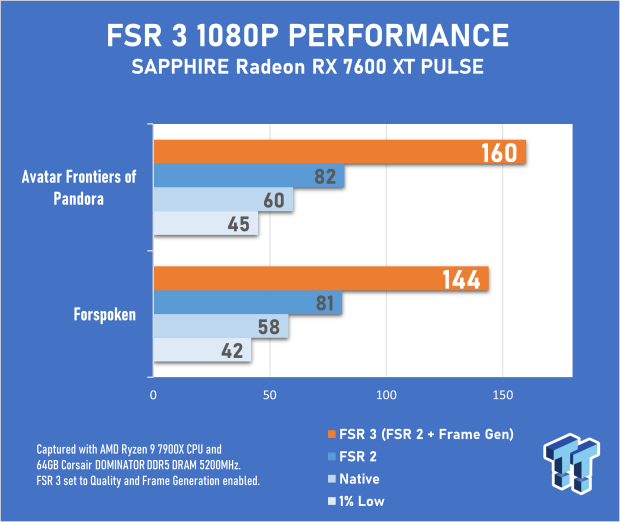
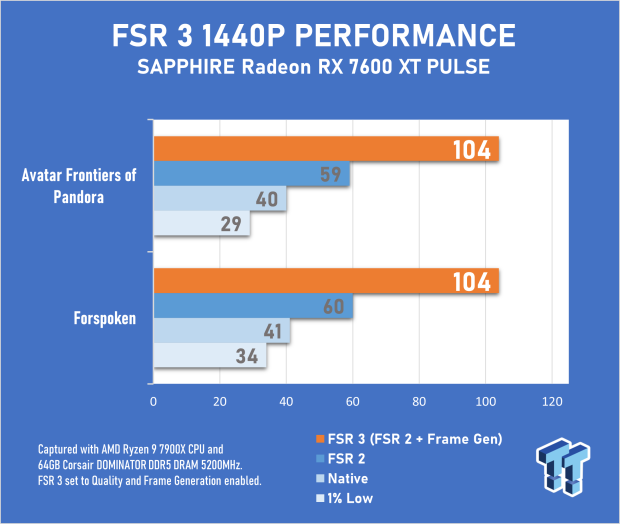
FSR 3's image quality, features, and overall performance have improved in a few short months, and the best example of this is Ubisoft's Avatar: Frontiers of Pandora, which sees perceived performance at 1080p increase by an impressive 2.7X. And with more titles adding FSR 3 support, it's great to see AMD's version of frame generation make progress. It's still not at the level of NVIDIA's DLSS 3 (as DLSS upscaling and Reflex are both the gold standard), but it's in a place where you would enable it.
Okay, let's shift gears to the exciting world of HYPR-RX, which allows you to enable upscaling (Radeon Boost) and frame generation (AMD Fluid Motion Frames) in any DirectX 11 or 12 title. Yeah, it's impressive that it works at all - and an exciting leap into groundbreaking new territory for AMD.
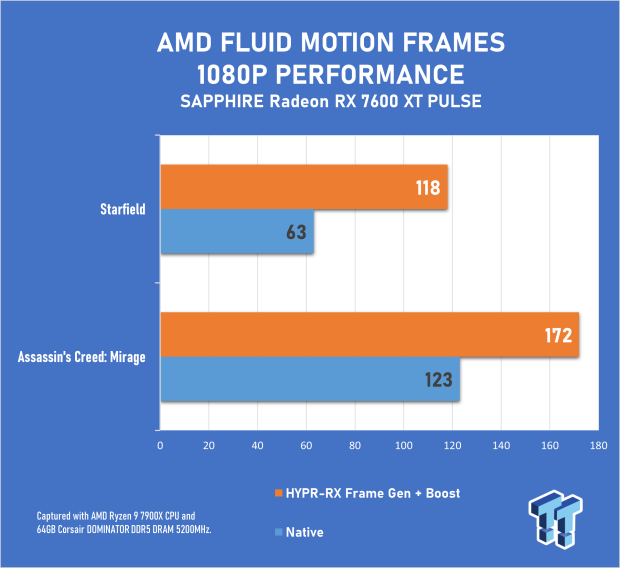
Above, we see AFMF and HYPR-RX enabled in Starfield and Assassin's Creed: Mirage - and the results are immediate and generally quite decent. However, at this stage, there is a big catch. Because the technology doesn't use game data like FSR 3 or DLSS 3, image quality suffers. AMD's approach here is performance in all games with some cost, and still early days for HYPR-RX - so here's hoping it's something where fidelity and overall stability improve in the coming months. The good news is that enabling the tech globally for a single game is a simple one-click process via AMD's Radeon software.
Temperature and Power Efficiency
In our stress test under full load, the SAPPHIRE PULSE AMD Radeon RX 7600 XT drew about 180W of power, which is more than the similarly performing GeForce RTX 4060 - a card that draws as little as 110W or so when gaming.
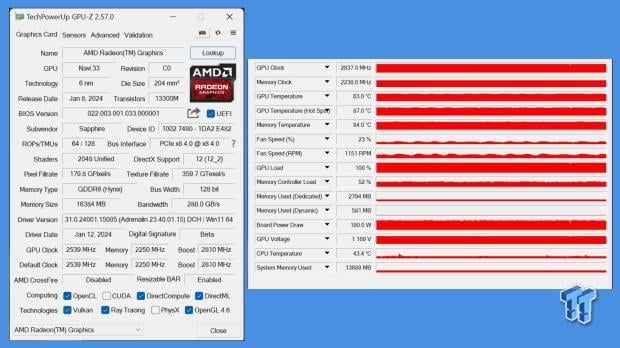
The cooling performance of the SAPPHIRE PULSE AMD Radeon RX 7600 XT is decent, with the GPU temperature hovering around 63 degrees with fan speeds kept to a modest and quiet 23% capacity. It definitely leaves some room for further overclocking, which you can do using Sapphire's easy-to-use TriXX software.
Final Thoughts
There are a few layers to the Radeon RX 7600 XT - the first and biggest one is the addition of 16GB of memory, double that of the baseline Radeon RX 7600. In select games, the additional memory does lead to notable performance double-digit improvements while making this one of the most affordable and only GPUs available for under $350, brand-new with 16GB of memory. The other major thing of note when it comes to the Radeon RX 7600 XT is that, for the most part, performance is roughly on par with the GeForce RTX 4060 and, on average, only a modest improvement over the baseline Radeon RX 7600.
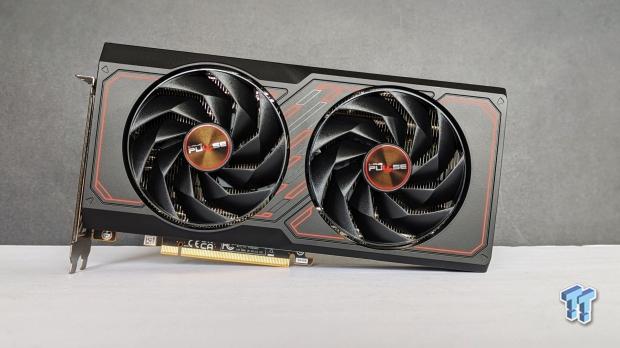
This makes the $60 price increase over the Radeon RX 7600 understandable and still disappointing. An additional 8GB of memory doesn't come cheap, but at the same time, a 22% price doesn't mean you're getting anything close to that in performance (on average).
Outside of gaming, having 16GB of VRAM is great for content creation, AI, and productivity - one area where the Radeon 7600 XT could look more attractive than the GeForce RTX 4060. Plus, with FSR 3, AV1 encoding, the new FSR-based video upscaling, and the driver-based frame generation that is a part of the HYPR-RX Radeon software, AMD is kicking off 2024 with more than just a GPU launch - but a range of new and impressive GPU-related technologies.

